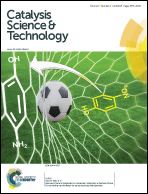Promotional effect of doping SnO2 into TiO2 over a CeO2/TiO2 catalyst for selective catalytic reduction of NO by NH3†
Abstract
TixSn1−xO2 was prepared by a co-precipitation method, and a series of CeO2/TixSn1−xO2 samples were prepared to investigate the effect of doping SnO2 into TiO2 for selective catalytic reduction of NO by NH3. The results of catalytic tests suggested that the catalyst with the optimal molar ratio (Ti : Sn = 1 : 1) exhibited the best catalytic performance. Moreover, the NO removal efficiency of CeO2/Ti0.5Sn0.5O2 was higher than that of CeO2/TiO2. The obtained samples were characterized by BET, XRD, H2-TPR, XPS, NH3-TPD and in situ DRIFT. The results revealed that the introduction of SnO2 resulted in the formation of rutile-type Ti0.5Sn0.5O2 solid solution with larger specific surface area and better thermal stability. The interactions between CeO2 and the Ti0.5Sn0.5O2 support could improve the redox performance of the catalyst, which was beneficial to the enhancement of catalytic activity at low temperature. Furthermore, doping SnO2 enhanced the surface acid sites and weakened the adsorption of nitrates, which played an important role in the catalytic reaction process. Finally, in situ DRIFT demonstrated that the competition adsorption happened between bridging nitrates and NH3 gas and the selective catalytic reduction of NO by NH3 proceeded mainly via the Eley–Rideal mechanism over Ce/TiO2 and Ce/Ti0.5Sn0.5O2.


 Please wait while we load your content...
Please wait while we load your content...